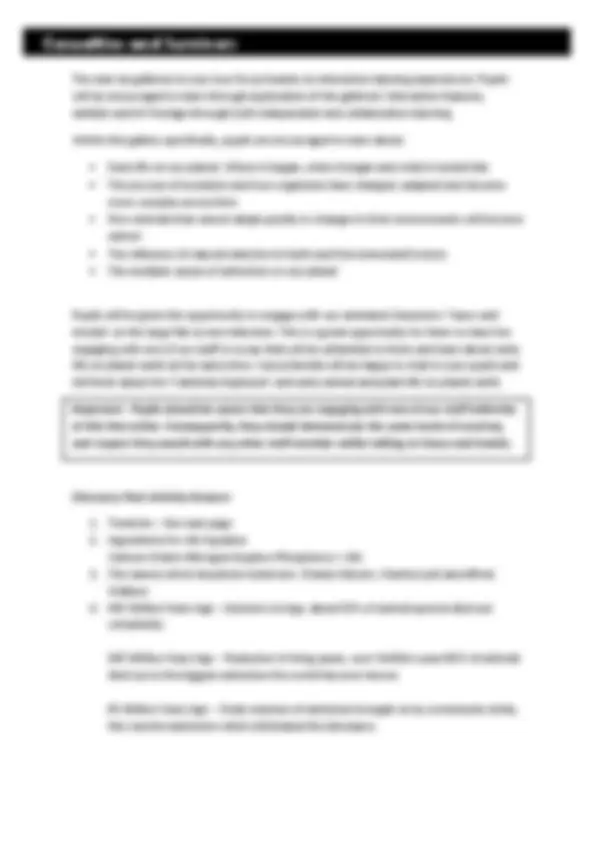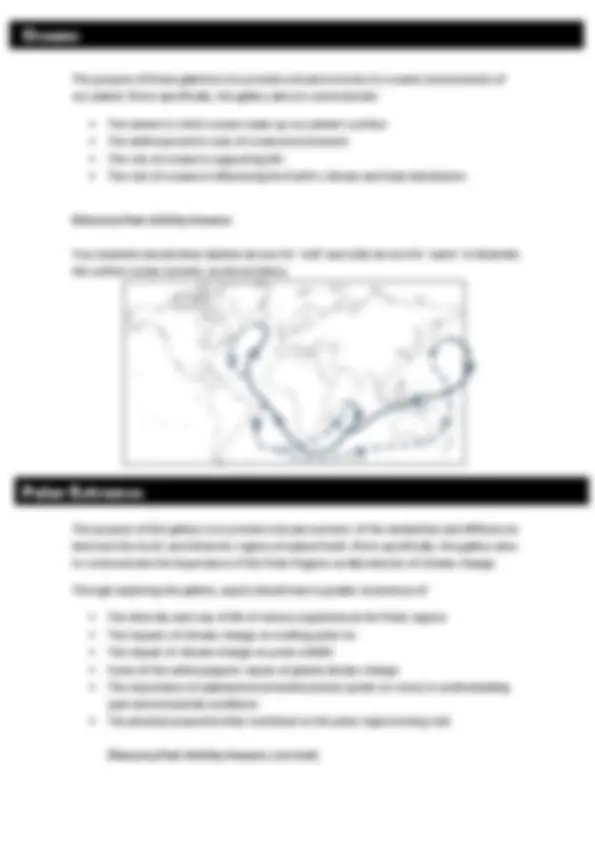








Study with the several resources on Docsity

Earn points by helping other students or get them with a premium plan


Prepare for your exams
Study with the several resources on Docsity

Earn points to download
Earn points by helping other students or get them with a premium plan
Community
Ask the community for help and clear up your study doubts
Discover the best universities in your country according to Docsity users
Free resources
Download our free guides on studying techniques, anxiety management strategies, and thesis advice from Docsity tutors
This guide has been designed to complement the 'Secondary School Discovery Pack' to ... Discovery Pack Activity Answers. 1. TimeLine – See next page. 2.
Typology: Study notes
1 / 11

This page cannot be seen from the preview
Don't miss anything!







Welcome to Our Dynamic Earth!
This guide has been designed to complement the ‘Secondary School Discovery Pack’ to help you get the most out of your experience with us.
This Discovery Pack has been designed to help your pupils engage with gallery content and think critically about the material presented. It is curriculum-linked to meet the needs of several Curriculum for Excellence Experiences and Outcomes.
The purpose of this teacher’s guide is to assist you in making the most out of this pack, and give you a resource that provides you with both organisation and flexibility to ensure that as many pupils as possible get the most out of their time in the galleries.
The following sections provide you with an overview to each gallery and the activities designed for your pupils within their discovery pack.
Curriculum links are highlighted in the last section of this guide.
We hope you find these resources useful in enhancing your experience and we would welcome your feedback on these resources so we can make them even better. Email: emma.paterson@dynamicearth.co.uk
For more ideas and resources please visit our website www.dynamicearth.co.uk and click on the section for teachers.
The next 4 galleries in your tour are designed to be multisensory and immersing experiences where you are encouraged to: look, listen, smell and feel as though you are being literally transported through space and time. You will be looked after in these galleries by a member of the Visitor Services team, who will always be nearby should you require any assistance.
The Time Machine – The time machine will take you back 13.7 billion years into the past using audio visual special effects. The time machine highlights the importance of ‘Deep- Time’ – the concept of Hutton explored in ‘Scotland’s Time Lord’s – and its contribution to our understanding of Earth and Environmental Science. You will be in the time machine for 90 seconds. Please inform your Visitor Services Assistant if there is any pupil/accompanying adult who does not want to use the Time Machine: they will be escorted safely by a member of our team 13.7 billion years back in time via a stairwell.
How it All Started – As the Time Machine doors open, you will be met by a Visitor Services Assistant to take you onboard the observation deck of a space ship. An AV will begin shortly providing an overview to the formation of our universe and the structure of our planet.
Restless Earth – Your Visitor Services Assistant will take you into the next gallery: a volcanic eruption and earthquake simulator with supporting AV footage. The gallery highlights the role of continental processes explored initially in Scotland’s Time Lords in greater depth: the birth and death of oceans, the creation of mountains, volcanic eruptions and earthquakes.
Please be advised that a moving floor and strobe lighting are used in this gallery. Please seek assistance from your Visitor Services Assistant should some pupils/adults need to bypass this gallery.
Shaping the Surface – Your Visitor Services Assistant will lead you on into your helicopter flight across glaciated landscapes of Scotland and Norway. This gallery uses AV footage to convey the power of ice and running water to shape the landscapes of Scotland. Processes of erosion, transportation and deposition are considered.
At the end of this AV, your Visitor Services Assistant will introduce the next gallery to you which explores the processes of evolution and extinction.
Please be aware that the next six galleries in the tour are self-guided. Should you require any assistance from this point you can find a Visitor Services Assistant through the doors in front of you as you enter the Casualties and Survivors gallery, or alternatively in the 4D gallery later on in your tour.
The next six galleries in your tour focus heavily on interactive learning experiences. Pupils will be encouraged to learn through exploration of the galleries’ interactive features, exhibits and AV footage through both independent and collaborative learning.
Within this gallery specifically, pupils are encouraged to learn about:
Early life on our planet: Where it began, when it began and what it looked like The process of evolution and how organisms have changed, adapted and become more complex across time How animals that cannot adapt quickly to changes in their environments will become extinct The influence of natural selection in Earth and Environmental Science The multiple causes of extinction on our planet
Pupils will be given the opportunity to engage with our animated characters ‘Vasco and Amelia’ on the large flat screen television. This is a great opportunity for them to have fun engaging with one of our staff in a way that will be unfamiliar to them and learn about early life on planet earth at the same time. Vasco/Amelia will be happy to chat to your pupils and tell them about the ‘Cambrian Explosion’ and early animal and plant life on planet earth.
Important - Pupils should be aware that they are engaging with one of our staff indirectly at this interactive. Consequently, they should demonstrate the same levels of courtesy and respect they would with any other staff member whilst talking to Vasco and Amelia.
Discovery Pack Activity Answers
245 Million Years Ago – Reduction in living space, over 3million years 96% of animals died out in the biggest extinction the world has ever known.
65 Million Years Ago – Chain reaction of extinction brought on by a meteorite strike, this was the extinction which eliminated the dinosaurs.
Satellites play a really important role in understanding our planet’s surface. Look at the slideshow of the satellite images and match them up to the correct labels.
The purpose of these galleries is to provide a broad overview to oceanic environments of our planet. More specifically, the gallery aims to communicate:
The extent to which oceans make up our planet’s surface The anthropocentric uses of ocean environments The role of oceans in supporting life The role of oceans in influencing the Earth’s climate and heat distribution
Discovery Pack Activity Answers
Your students should draw dashed arrows for ‘cold’ and solid arrows for ‘warm’ to illustrate the surface ocean currents, as shown below.
The purpose of this gallery is to provide a broad overview of the similarities and differences between the Arctic and Antarctic regions of planet Earth. More specifically, the gallery aims to communicate the importance of the Polar Regions as laboratories of climate change.
Through exploring the gallery, pupils should have a greater awareness of:
The diversity and way of life of various organisms at the Polar regions The impacts of climate change on melting polar ice The impact of climate change on polar wildlife Some of the anthropogenic causes of global climate change The importance of paleaoenvironmental proxies (polar ice cores) in understanding past environmental conditions The physical properties that contribute to the polar regions being cold
Discovery Pack Activity Answers (overleaf)
I can sample and identify living things from different habitats to compare their biodiversity and can suggest reasons for their distribution. SCN 3-01a
I understand how animal and plant species depend on each other and how living things are adapted for survival. I can predict the impact of population growth and natural hazards on biodiversity. SCN 4-01a
I can use my knowledge of the different ways in which heat is transferred between hot and cold objects and the thermal conductivity of materials to improve energy efficiency in buildings or other systems. SCN 3-04a
By investigating renewable energy sources and taking part in practical activities to harness them, I can discuss their benefits and potential problems. SCN 3-04b
I can explain some of the processes which contribute to climate change and discuss the possible impact of atmospheric change on the survival of living things. SCN 3-05b
By using my knowledge of our solar system and the basic needs of living things, I can produce a reasoned argument on the likelihood of life existing elsewhere in the universe. SCN 3-06a
By researching developments used to observe or explore space, I can illustrate how our knowledge of the universe has evolved over time. SCN 4-06a
I have collaborated with others to find and present information on how scientists from Scotland and beyond have contributed to innovative research and development. SCN 3-20a
I have researched new developments in science and can explain how their current or future applications might impact on modern life. SCN 4-20a
Having selected scientific themes of topical interest, I can critically analyse the issues, and use relevant information to develop an informed argument. SCN 4-20b
I can make links between my current and previous studies, and show my understanding of how people and events have contributed to the development of the Scottish nation. SOC 3-02a
I have developed a sense of my heritage and identity as a British, European or global citizen and can present arguments about the importance of respecting the heritage and identity of others. SOC 4-02a
Having investigated processes which form and shape landscapes, I can explain their impact on selected landscapes in Scotland, Europe and beyond. SOC 3-07a
I can explain how the interaction of physical systems shaped and continue to shape the Earth’s surface by assessing their impact on contrasting landscape types. SOC 4-07a
I can identify the possible consequences of an environmental issue and make informed suggestions about ways to manage the impact. SOC 3-08a
I can discuss the sustainability of key natural resources and analyse the possible implications for human activity. SOC 4-08a
I can investigate the climate, physical features and living things of a natural environment different from my own and explain their interrelationship. SOC 3-10a
I can develop my understanding of the interaction between humans and the environment by describing and assessing the impact of human activity on an area. SOC 4-10a
I can identify threats facing the main climate zones, including climate change, and analyse how these threats impact on the way of life. SOC 4-12a
I can use specialised maps and geographical information systems to identify patterns of human activity and physical processes. SOC 4-14a